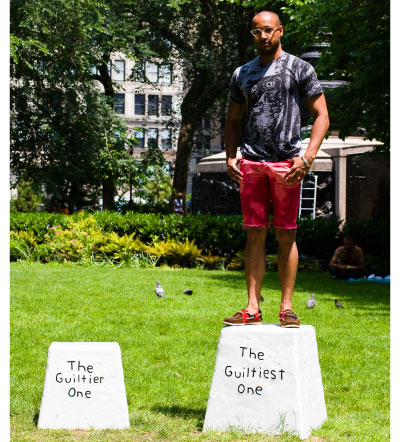
Miranda July, Eleven Heavy Things, Union Square, New York, NY. Photography by Brian Paul Lamotte. Courtesy of the Artist, Deitch Projects, NYC Parks & Recreation, and the Union Square Partnership.
(Click images to enlarge)

If you’ve walked through Union Square recently, you’ve likely come across Miranda July’s
Eleven Heavy Things. The cast fiber-glass, steel-lined sculptural works (although July herself rarely refers to them as sculptures) invite viewer participation: a series of pedestals in ascending height read The Guilty One, The Guiltier One, and the Guiltiest One; an otherwordly hanging shape made of lace creates an intricate, alien headdress; a series of tablets with holes invite the insertion of arms, legs, and a finger (which reads, “This is not the first hole my finger has been in, nor will it be the last”). Another pedestal built for two people reads, “We don’t know each other, we’re just hugging for the picture.”
July seeks here to bring organic performance on the part of the viewer, rather than simply display works of art. And the beauty of these pieces lies in the interactions that they successfully create: tourists and native New Yorkers alike can be seen at all hours of the day posing for pictures as the Guiltier One, poking limbs through bizarre holes, and hugging strangers “for the picture”. A simple search through
Flickr for “eleven heavy things” is enough to reveal how extensive public participation has already been in this project.
Originally created for the Venice Biennale,
Eleven Heavy Things is presented in New York by
Deitch Projects as its last and final public project. The exhibit will be on display until October 3, 2010 in Union Square.
(more…)
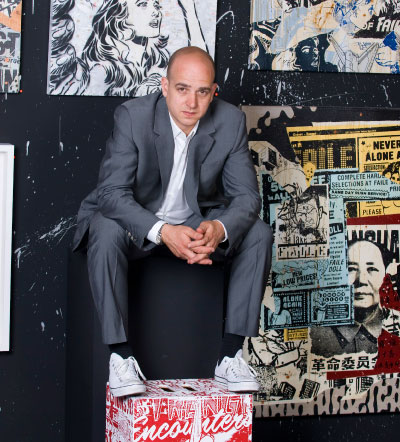
Photography by Ian Cox, Steve Yennie and Yuri Hasegawa (Click Images to Enlarge)
 Unconventional is a term that pops up a lot whenever Steve Lazarides is mentioned. Rather than limit himself, or the artists he represents, as strictly street, urban, or graffiti, he’s adopted the word “outsider”: an overarching term that encompasses a myriad of implications and techniques. Over the past four years, the forward-thinking gallerist has not only lived up to this term but done so with outstanding success — three thriving galleries, a slew of sold-out shows, and a growing roster of innovative artists that are literally becoming household names as I write.
Unconventional is a term that pops up a lot whenever Steve Lazarides is mentioned. Rather than limit himself, or the artists he represents, as strictly street, urban, or graffiti, he’s adopted the word “outsider”: an overarching term that encompasses a myriad of implications and techniques. Over the past four years, the forward-thinking gallerist has not only lived up to this term but done so with outstanding success — three thriving galleries, a slew of sold-out shows, and a growing roster of innovative artists that are literally becoming household names as I write.
Following the indelible roar generated by Banksy’s Barely Legal show in 2006 and the Outsiders show in 2008, it would have been easy to assume that everything Lazarides produced from then on would follow the same winning formula. Yet he has continued to push boundaries, take risks, unearth wickedly good talent, and make outsider art media savvy, all while snubbing art-world standards.
The mogul’s latest endeavor is a four-month stint in an 8,000-square-foot venue in the consumer-driven heart of Beverly Hills. Opening with the gigantically talented David Choe in April, followed by Eurotrash on June 9, the plan is to unveil a new, unique exhibit each month.
(more…)

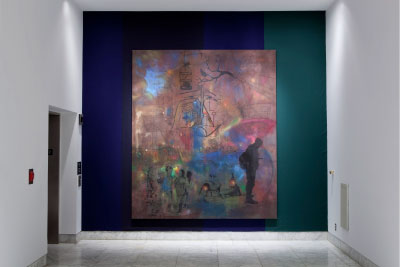
We Are Not As Far West As We Suppose We Are (California), 2010. All artwork by Friedrich Kunath. Photography by Joshua White.
Artwork Courtesy of the artist; Blum & Poe, Los Angeles ; BQ, Berlinl; and Andrea Rosen Gallery, New York.
(Click image to Enlarge)

For the Hammer Project’s current exhibition, German-born artist Friedrich Kunath has created a realm of comi-tragedies based around middle-aged men struggling to reconcile their imagined lives and unmet desires with the sharp reality of a mediocre existence. Employing as many mediums as he could (drawing, painting, sculpture, photography, even a neon sign reading “I am Goodbye”) Kunath chose to let his ideas spread out. Both walls of the lobby stairwell at LA’s
Hammer Museum are filled with a hodge-podge of work in assorted sizes. The installation peaks with a series of soft, colorful washes overlaid with thin line drawings and silhouettes of nondescript men climbing staircases into eternity, slumped anxiously over an office desk, or popping stunned out of a jack-in-the-box, briefcase in hand. Each solitary male character appears slightly dazed or lost, caught midway between the world’s external confusion and the banality of everyday routine. Like a Saul Bellow character desperately proselytizing the meaning of life to an empty apartment, Kunath’s men are in the process of a tumultuous transition.
(more…)

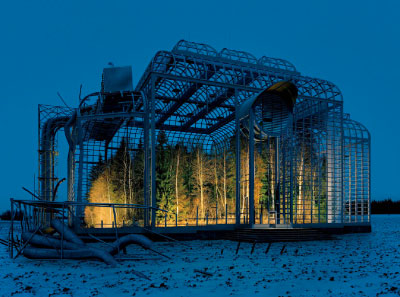
Ilkka Halso, Museum of Nature: Museum I, 2003. All images courtesy of Museum fur Kunst und Gewerbe (Click images to enlarge)

Just as governments begin to implement policies and practices to slow global climate change, some designers are jumping ship. They fear that our environment is damaged beyond repair and are thinking up ways for us to survive the impending apocalypse. A new show at the
Museum fur Kunst und Gewerbe in Hamburg,
Climate Capsules: Means of Surviving Disaster, gives credence to their ideas.
These artists attack the problem at various scales. Some are creating specialized articles of clothing to protect the human body from increasingly damaging atmospheric conditions. Lucy Orta crafted a tent-like, nylon garment that gives protection from the light, heat, cold, and water. Equipped with its own whistle, lantern, and compass, it’s like a highly-evolved all-weather coat. Performance artist Lawrence Mastaf designed a clear vacuum-sealed plastic trap for himself, in which he lies suspended with only slender tubes to breathe through. It’s a spectacle that’s both eery and peaceful. He’s preserved like a biological specimen, and floating dreamily like an embryo.
(more…)
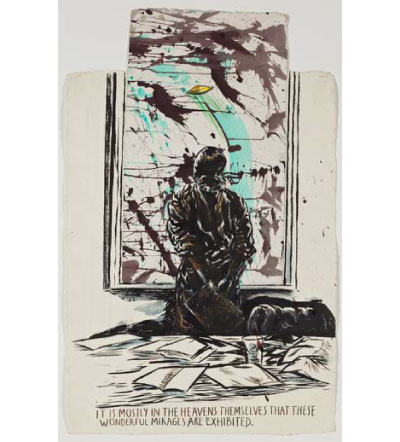
No Title (It is mostly), 2010. All artwork by Raymond Pettibon. Courtesy of Gladstone Gallery.

Raymond Pettibon, the guru of grungy great works on paper, has a new series at Gladstone in Brussels through July 10. For someone whose output has sustained itself for decades within a fairly narrow range, it’s such a thrill to see the interest and variety in the work continue to increase. The fifteen or so dirty doggies in this show feature some staple symbols (Jesus, fighter planes, cloudy oceans, and text text text) but overall seem to be — as is typical of Pettibon at his best — chick-driven and philosophical.
Meditations on sexual anxiety morph into poetic perambulations on semantic meaning and symbolic anxiety. How meaning is made in the brain and the relationship between words and images seem to form the basis of these explorations in ink, pen, and gouache. Slippery signifiers, another Pettibon staple, reproduce on the page as his pop culture-crammed psyche plays itself out. A small and self-referential sounding piece professes that he only wants “slow, calm drawing and daydreaming over a thing till it arranges itself”.
An increased use of collage in this group makes things kind of hectic, the anxiety building with the thickness of the layered imagery. The raggedy torn edges of the paper, and his signature fraying brushtrokes that split as the brush empties itself of ink, keep them rough and ready, in the present, and never quite finished off. Distinctly un-dainty, his pieces seem to growl at you and like the grumpy cloud in one work, serve “to make the swell grow”.
(more…)

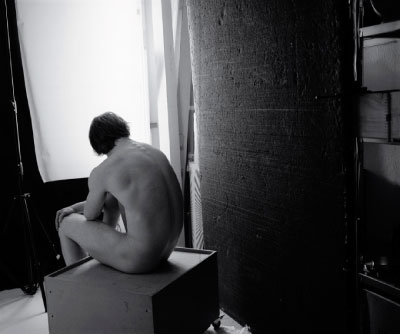
All photography courtesy of Joscha Bruckert and Andreas Till.
(Click images to enlarge)

 A Man Sat Alone In His Room
A Man Sat Alone In His Room is the result of the collaboration between
Joscha Bruckert and
Andreas Till, photography students in Dortmund, Germany. The two are self-proclaimed “lonely workers”, which helps explain the subject matter of their project. The self-published book of luminous portraits, collages, and found images, is “about the night and everything that comes along with it”, writes Bruckert via email. “Starting with…the night sky and the phenomenon of darkness itself”, the end result is “a very heterogeneous collection of photographic fragments that add up to what the night means to us”.
Till writes, “For me, the book is like a thought bubble in which many thoughts, ideas and desires circle around each other like the planets of our universe. They influence each other, but as they differ so much in respect of volume, texture, and maybe size, they will stay in their own orbit.” The subject matter on these pages ranges wide, but the colors and forms reverberate off of each other in their exploration of nighttime, and together evoke what it feels to be awake as the dark lonely hours stretch into morning.
Joscha Bruckert is the editor of
Romka, a photography magazine that features the personal photos of professional, student, and amateur photographers from all over the world. Till is working on several other projects and plans to enroll in an MFA program at Ohio University in the fall.
A Man Sat Alone In His Room is available in its first edition of fifty copies, numbered and signed. All copies include four free posters, and can be ordered online
here.
(more…)

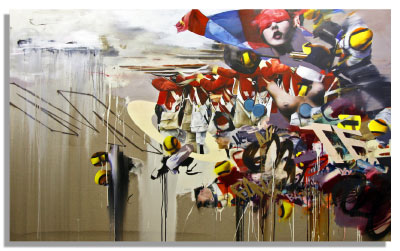
Bang Bang, You Shot Me Down, Conor Harrington. Photography courtesy of LAzarides. (Click Images to Enlarge)


When he was just starting out four years ago, Steve Lazarides was the man behind the man. Considering many of his artists work under the cloak of secrecy, you’d think that would’ve left him in relative obscurity. But with a stable of names such as French street art godfather Invader, Radiohead’s long time artist Stanley Donwood, Banksy, and Brooklyn wheatpaste kings Faile, he has become the focus of increased attention across the art world. Next week, his upstart UK gallery, Lazarides, will begin the second phase of its five-month LA stint with the awesomely named Eurotrash — a group show including breakout JR, Antony Micallef, Conor Harrington, and Vhils. Lazarides’ eye for talent and new forms of renegade, sometimes vandal art feels like a renaissance of Tony Shafrazi’s legendary ’80s New York gallery, which launched the careers of Basquiat, Keith Haring, and Futura 2000. Here in LA, he fits in with the city’s most ambitious impresarios with this pop-up spectacle. An 8,000 square-foot space in the heart of posh Beverly Hills, it feels like both an attack on the upper crust and perhaps a provocative statement of art nouveau riche. The visit opened back in April with a daunting solo show from misfit David Choe, which could’ve been four separate shows (oil painting, drawings, huge inflatable “sculptures”, and XXX graffiti) and continues through September. Like the legendary Banksy show Lazarides staged four years ago, it’s an event that will still have people talking once it’s gone.
Eurotrash opens June 8 at
LAzarides, 320 N Beverly Drive, Beverly Hills, 90210
(more…)

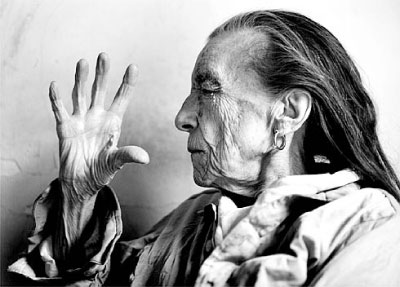
Photography by Annie Liebovitz


Louise Bourgeois was a remarkably prolific and giving artist, who over a lifetime of working created a language — beautiful, organic, sometimes terrifying, sensual, and abstract — that taught you what listening was really about. She was self-sacrificing in her work, which often necessitated an exploration of guilt and shame and littleness, as well as that inherently fraught and awkward business of human interaction. But she went down into the shadows only to climb back up, bearing something to give, every time, and most present in her work is a strong, clear drive for rapport, what she called the “
toi et moi”, our need to understand and connect with each other, without which we would be very lost. Her work communicated the universal, but in that strange, particularizing way it was also instantly recognizable as hers. As Bourgeois herself said in 1994, “All our subjects are the same: anything I say would apply to any of us. So, it’s not a mystery. The mystery resides in what you do with it.”
(more…)

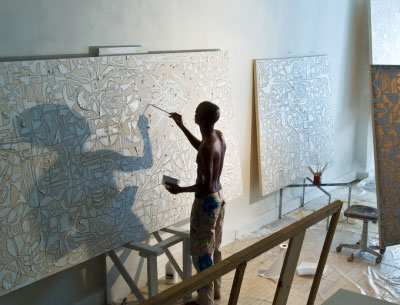
Victor Matthews in his Studio. Photography by Steven Lowy. All artwork by Victor Matthews. Courtesy of Wendt Gallery 2010. (Click images to enlarge)


Through June 22, the
Wendt Gallery in Midtown Manhattan is host to one of the more beautiful and intriguing shows of contemporary paintings you will find in the borough that is also its muse.
Alter Ego Paintings brings together a series of large-scale canvases and smaller pastels by Victor Matthews, an artist who has been living and producing in Manhattan since the mid-’80s, alongside Warhol, Keith Haring, Basquiat, Kenny Scharf, and Clemente. The serenity and active simplicity of the paintings suggest not only Matthews’s rich artistic partnership with New York, but the way in which we all seek to be on intimate terms with the places we live in — especially this blaring and shaking city that keeps trying to re-make itself into something else.
On a visual level there is a rightness to the way Matthews is using space that is unmistakable, an invisibly constructed symmetry and balance. The paintings have a Modernist sensibility. Set on a palate of white, the interplay between the textures of paint and the treated, raw-colored canvas is a harmonious and shifting affair, demarcated by a strong presence of the two-dimensional — of line. This is where the works begin, with an unchangeable, fluid drawing in wax pencil that is both conceived and created in the same moment. The artist doesn’t do studies, relying instead on a second-sense for both the beauty and the infinite possibilities in the bisecting of space. As Brice Marden has observed, Victor Matthews has “the line”.
(more…)





 Facebook
Facebook Permalink
Permalink Digg
Digg Reddit
Reddit LinkedIn
LinkedIn StumbleUpon
StumbleUpon Tumblr
Tumblr
















